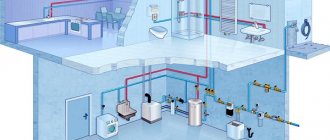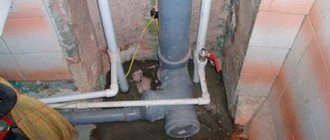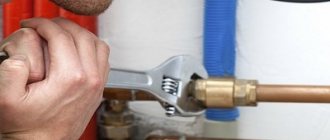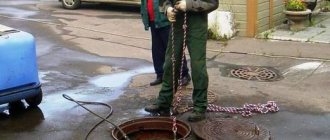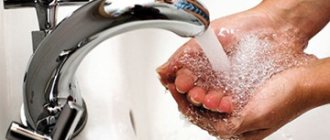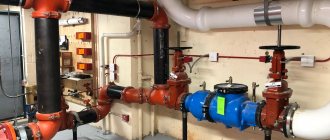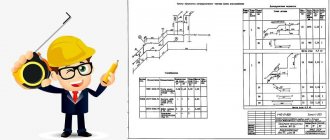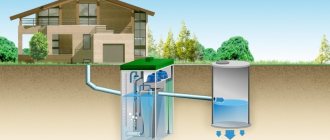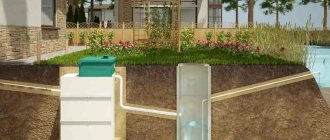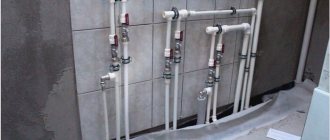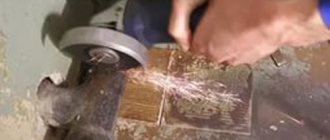Water metering unit of a residential building after major repairs
The topic of our article today is the repair of cold and hot water supply systems. We have to find out what the difference is between emergency, current and major repairs, how long it takes to completely replace the building’s water supply system, what materials are used to carry it out, and how individual faults in the engineering systems of a residential building are eliminated. For the convenience of the reader, we will structure the article in the form of answers to frequently asked questions.
Definitions
- What are the differences between the types of repair of engineering systems?
- Emergency repairs are a set of urgent measures designed to eliminate flooding of residential and common premises, as well as restore water supply to the consumer;
- Routine repair of the water supply system includes measures to eliminate faults that are not related to the cessation of utility services or emergency flooding. For example, eliminating a break in a cold water supply riser is considered an emergency repair, and replacing its section in order to restore the dropped water pressure is considered an ongoing one;
Current repairs: cold water supply through the riser has been restored using a polypropylene pipe
- Planned preventive maintenance of water supply is aimed at restoring or maintaining the functional properties of equipment, structural elements or components. This includes, for example, periodic welding of valve wedges and restoration of the diameter of retaining washers worn out by erosion in the elevator unit;
- Finally, overhaul is aimed at completely restoring the operational properties of the engineering system or its individual components. Examples are complete replacement of cold water and hot water systems, replacement of a bottling or water meter unit.
Overhaul of the water supply system: fillers and risers replaced
Please note: there are no clear boundaries between types of repairs. For example, it is difficult to distinguish current water supply repairs from major repairs in the case of a complete replacement of a worn-out water supply riser. The same applies to emergency and routine repairs: welding a fistula on an eyeliner or heated towel rail can be classified in one category or another depending on the size of the defect.
Current repairs of cold water supply: replacement of the bottling area
Periodicity
- How long does it take for a water supply system to need major repairs?
The vast majority of buildings in use were built during the USSR or in the early post-Soviet years and were equipped with steel water pipelines.
Departmental construction standards VSN 58-88 establish for them the following periods between repairs:
- Galvanized cold water pipes - 30 years;
- Black cold water pipes - 15 years;
- Galvanized hot water pipes with a closed heat supply system - 20 years;
- Black hot water pipes with a closed heating supply system - 10 years;
- Galvanized hot water pipes with an open heating supply system - 30 years;
- DHW pipes are black with an open heating supply scheme - 15 years.
The document establishes the service life of building structures and engineering equipment
When setting the timing of repair work, the actual state of the water supply is taken into account: major repairs, for example, are still not required for many Stalinka buildings with galvanized water pipes assembled on threaded connections.
Galvanized pipes are mounted on threads. Welding burns the zinc coating and the seam begins to rust
Payment
- At whose expense are repairs carried out?
Emergency repairs of hot water supply and cold water supply are usually performed free of charge for residents. If a water leak occurs through their fault (due to errors in self-installation of the water supply system, etc.), the emergency service turns off the problem area of the water supply system (pipeline or riser), transferring the request to the maintenance service.
Further. Different sections of the water supply system may belong to the property of the apartment owner or to the common property of the residents of the house.
The boundary passes through the connection of the tap on the supply line to the branch from the riser: everything before this connection is common property, the tap itself and the connections after it are individual property. If the general water supply is faulty, current repairs are carried out at the expense of the management company, if individual, the elimination of the fault is paid by the owner.
Repair of a bathroom with water supply is carried out at the expense of the homeowner
Scheduled preventive maintenance affects only the common property of residents and is carried out at the expense of the management company (more precisely, the costs for it are covered by utility bills).
Finally, the cost of major repairs is included in the rent as a separate item. It is carried out as the required amount accumulates in municipal accounts.
Payment for major repairs of a building
Please note: by decision of the residents' council, major repairs may be carried out ahead of schedule. In this case, the lack of funding is covered by the residents from their own funds, after which they are for some time exempt from paying contributions for repair work.
In-house engineering systems are the year 2021
In-house engineering systems included in the common property of an apartment building
In accordance with clause 3, part 1, art. 36 Housing Code of the Russian Federation, paragraphs. d" clause 2 of the Rules for the maintenance of common property in an apartment building, approved by Decree of the Government of the Russian Federation of August 13, 2006 N 491 (hereinafter - Rules N 491) as part of the common property owned by the right of common shared ownership to the owners of premises in an apartment building (hereinafter - common property), includes electrical, sanitary and other equipment (hereinafter referred to as in-house engineering systems) located in an apartment building outside or inside the premises and serving more than one residential and non-residential premises.
According to clause 5 of Rules No. 491, in-house engineering systems include:
1) cold and hot water supply systems, consisting of:
— branches from the risers to the first disconnecting device located on the branches from the risers;
- collective (common house) cold and hot water meters
— the first shut-off and control valves on the branches of the intra-apartment wiring from the risers
— mechanical, electrical, sanitary and other equipment located on cold and hot water supply networks;
2) a drainage system, which includes:
— sewer outlets, fittings (including bends, transitions, pipes, audits, crosses, tees);
— risers, branches from risers to the first butt joints;
- plugs, exhaust pipes, drainage funnels, cleanouts, as well as other equipment located in this system;
3) the gas supply system in which they are included;
- gas pipelines laid from the gas source (when using liquefied petroleum gas) or the point of connection of these gas pipelines to the gas distribution network up to and including the shut-off valves (taps), located on branches (drops) to the in-house gas equipment;
The outer boundary of the gas supply networks that are part of the common property is the point of connection of the first shut-off device with the external gas distribution network (clause 9 of Rules No. 491).
— tank and (or) group cylinder installations of liquefied hydrocarbon gases, designed to supply gas to one apartment building (when using liquefied hydrocarbon gas);
— gas-using equipment (with the exception of household gas-using equipment that is part of the indoor gas equipment);
— technical devices on gas pipelines, including control and safety valves;
— indoor gas control system;
— collective (common house) gas meters;
— gas metering devices that record the volume of gas used in the production of utility services for heating and (or) hot water supply (in the case of independent production of these services);
4) a heating system consisting of;
— control and shut-off valves;
— collective (common house) heat energy metering devices;
5) power supply system, which includes:
— protection, monitoring and control equipment;
— collective (common house) electrical energy metering devices;
— lighting installations for common areas;
— electrical installations of smoke removal systems;
— automatic fire alarm systems for internal fire water supply, freight, passenger and fire elevators;
— automatic locking devices for the entrance doors of an apartment building;
— networks (cables) from the outer boundary of electrical networks to individual, general (apartment) electrical energy metering devices, as well as other electrical equipment located on these networks.
It should be noted that in accordance with clause 8 of Rules N 491, the external boundary of the electrical, heat, water supply and sewerage networks that are part of the common property is the external boundary of the wall of an apartment building, and the boundary of operational responsibility in the presence of a collective metering device for the corresponding utility resource, unless otherwise established by the agreement of the owners of the premises with the provider of utilities or the resource supplying organization, is the place of connection of the collective metering device with the corresponding engineering network included in the apartment building (see the decision of the Supreme Court of the Russian Federation dated November 1, 2017 N AKPI17-700).
The current version of the document you are interested in is available only in the commercial version of the GARANT system. You can purchase a document for 54 rubles or get full access to the GARANT system free of charge for 3 days.
If you are a user of the Internet version of the GARANT system, you can open this document right now or request it via the Hotline in the system.
» Encyclopedia of solutions. Management companies in apartment buildings" is a set of unique updated analytical materials aimed at accountants, specialists in financial and economic services, lawyers of organizations and individual entrepreneurs engaged in the management of apartment buildings on the basis of management agreements for apartment buildings
Each material is supported by references to regulatory legal acts, takes into account existing judicial practice and is updated as legislation changes.
The material is updated as of July 2021.
See the contents of the Encyclopedia of Solutions. Management companies in apartment buildings
When preparing the section “Encyclopedia of Solutions. Management of apartment buildings" uses original materials provided by V. Glebov, I. Razumova
Six years have passed since the Housing Code of the Russian Federation came into force. On its basis, the Government of Russia adopted such resolutions as No. 307 of May 23, 2006. “On the procedure for providing public services to citizens” and instead of it - May 6 of this year. No. 354 “On the provision of utility services to owners and users of premises in apartment buildings and residential buildings”, No. 491 dated August 13, 2006, approving the Rules for the maintenance of common property in an apartment building. These and similar documents use terminology that is unusual and therefore incomprehensible to people who are far from legal subtleties and who put their everyday meaning into them. But even among lawyers they are perceived ambiguously, since in various regulatory documents they are interpreted and defined differently, causing difficulties and disputes. These include the concepts set out in clause 2 of the Rules for the provision of utility services to owners, which define the concept, composition and distribution of responsibility for the maintenance of the property of an apartment building (MKD) and residential building.
This is interesting: Distance from parking to residential building 2021
So, the first concept is in-house engineering systems. They are defined as the common property of the owners of premises in an apartment building, engineering communications (networks), mechanical, electrical, sanitary and other equipment intended for supplying utility resources from centralized utility networks to intra-apartment equipment, as well as for the production and provision of provider of utility services for heating and (or) hot water supply (in the absence of centralized heat supply and (or) hot water supply).
OP: P.p. 3.3.1.8 Resolution of the State Construction Committee of the Russian Federation dated February 23, 1999. No. 9 includes a complex of engineering equipment located inside the building as intra-house networks: pipelines entering the building, individual heating devices (radiators, convectors, etc.), risers, expanders, tanks, floor and apartment wiring, plumbing equipment, electrical panels, etc. The boundary of responsibility is considered to be the wall of the building.
But according to pp. 8, 9 of the current Decree of the Government of the Russian Federation dated August 13, 2006. No. 491 On approval of the rules for maintaining common property in an apartment building, which has greater legal force in comparison with the above-mentioned Resolution, the outer boundary of electricity, heat, water supply and sewerage networks, information and telecommunication networks (including wired radio broadcasting networks, cable television, fiber optic network, telephone lines and other similar networks) included in the common property is the outer boundary of the wall of the apartment building, and the boundary of operational responsibility in the presence of a collective (common house) metering device for the corresponding communal resource, unless otherwise established by agreement of the owners of the premises with The provider of public services or the resource supplying organization is the point of connection of the collective (general house) metering device with the corresponding utility network included in the apartment building. The outer boundary of the gas supply networks is the point of connection of the first shut-off device with the external network.
In residential buildings, in-house engineering systems include those located within the land plot on which the residential building is located, as well as engineering communications (networks), mechanical, electrical, sanitary and other equipment located in the residential building, with the use of which utility services are consumed. Here, most often, the boundary of the section is the place where the communications of the house are connected to the centralized source of the resource.
But, according to the Federal Antimonopoly Service of the Rostov Region, the division boundary must coincide with the boundary of the land plot on which the house is located.
Thus, we have four points that establish the boundary of the division of responsibility: the metering unit for the consumed resource, the outer side of the wall of the house, the location of the branch of utility networks, the boundary of the land plot.
To avoid possible misunderstandings, it is necessary to conclude agreements with all resource supply organizations on the division of their boundaries.
And further. By default, the common property includes all intra-house networks and devices that serve more than one isolated room or apartment, according to the design and estimate documentation of the house. The same property that was installed after the apartment building was put into operation, for example, an automatic door locking device, intercoms, a water booster system, etc., must be included in the common property by the general meeting of owners of the apartment building premises. This will give the legal right to have it serviced by the management organization, and therefore to include payment for this service.
Close to the concept of in-house engineering systems is the concept of in-apartment equipment located in residential or non-residential premises in an apartment building and not included in the in-house engineering systems of an apartment building, engineering communications (networks), mechanical, electrical, sanitary and other equipment, with the use of which consumption is carried out utilities.
OP: According to Part 1 of Article 36 of the Housing Code of the Russian Federation, the owners of premises in an apartment building own, by right of common shared ownership, premises in a given house that are not parts of apartments and are intended to serve more than one premises in a given house, incl. inter-apartment landings, stairs, elevators, elevator and other shafts, corridors, technical floors, attics, basements in which there are utilities, other equipment serving more than one room in a given house, as well as roofs enclosing load-bearing and non-load-bearing structures of a given house, mechanical, electrical, sanitary and other equipment located in this house outside or inside the premises and serving more than one premises, the land plot on which this house is located, with elements of landscaping and landscaping and other equipment intended for the maintenance, operation and improvement of this houses and objects located on the specified land plot.
It follows from this that a sign of equipment as part of the general property of an apartment building is its intended purpose for servicing at least several rooms in the house. The list given in Article 36 of the Housing Code is open, representing only a listing of individual elements of common property. The presence in the Code of only one sign of equipment of common property, the openness of the list of the composition of property, the presence in the list of formulations and other equipment located on networks create difficulties in resolving the issue of the subject of responsibility for the maintenance of specific utilities and other objects.
Further clarification of the list of objects that are included in the general property of MKD was carried out by the Government of the Russian Federation in the Resolution dated August 13, 2006. No. 491:
clause 5: the common property includes in-house engineering systems of cold and hot water supply and gas supply, consisting of risers, branches from the risers to the first disconnecting device located on the branches from the risers, the specified disconnecting devices, collective (common house) cold and hot metering devices water, the first shut-off and control valves on the branches of the intra-apartment distribution from the risers, as well as mechanical, electrical, sanitary and other equipment located on these networks;
This is interesting: How to convert an apartment from residential to non-residential? 2021
clause 6: the common property includes an intra-house heating system, consisting of risers, heating elements, control and shut-off valves, collective (common house) heat energy meters, as well as other equipment located on these networks;
clause 7: the common property includes an in-house power supply system, consisting of incoming cabinets, input distribution devices, protection, monitoring and control equipment, collective (common house) electrical energy meters, floor panels and cabinets, lighting installations in common areas, electrical installations of smoke removal systems, automatic fire alarm systems of internal fire water supply, freight, passenger and fire elevators, automatically locking devices for doors of apartment building entrances, networks (cables) from the external border established in accordance with clause 8 of these Rules, to individual, general (apartment) electricity metering devices, as well as other electrical equipment located on these networks.
However, the conclusion about the responsibility of management organizations for the maintenance of all these elements of in-house equipment is controversial, since this contradicts the legislation on contractual principles in the field of housing relations.
In particular, in addition to heating risers, indoor heating devices (radiators, convectors) are often included in the common property. In-apartment risers for cold and hot water supply and sewerage are classified as common property, and intra-apartment wiring from the first disconnecting device with other equipment located further along the communication system (faucets, flexible connections to the flush tank, connecting hoses to the washing machine, etc.) is the individual property of apartment building residents. . The responsibility of the management organization in terms of indoor equipment is limited to the obligation to maintain risers, wiring to the first disconnecting device and the disconnecting device itself.
The same Housing Code (Article 162 Part 3) stipulates that the management agreement must indicate the composition of the common property of the house and the procedure for determining the amount of remuneration for services and work on managing it (Article 156 Part 7).
Thus, when determining the obligations and responsibilities of the management organization, it is necessary to be guided by the terms of the management agreement for a specific apartment building, which will avoid misunderstandings.
About other terms and concepts in our next issues.
If you take on the renovation of an apartment, then you cannot avoid the work that is associated with in-house engineering systems. But their installation and bringing into working condition require a lot of time and effort.
What are in-house engineering systems?
Various engineering systems are an integral part of a modern house - both apartment and country house. Their task is to provide residents with the necessary level of comfort. As a rule, the installation process of these systems is very long and practically impossible without the experience of specialists with the necessary qualifications. What do we mean when we talk about in-house engineering systems?
If you are about to install a heating system, then your first step is design. You should start by determining the amount of heat for each room. It is important to take into account possible heat loss. Having collected the necessary data, you can begin to select a heating boiler of the required power.
The purpose of this engineering system is to provide residents of the house with hot and cold water. In this case, you can either connect the object to a centralized water supply or organize an autonomous fence.
Please pay attention to the need to carry out the wiring correctly, using different types of pipes, fittings and shut-off valves.
The more responsible you are in choosing pipes and fittings, the longer your water supply system will last. The diameter of the pipes should be determined based on the amount of water required for residents. This is the only way you will be able to achieve a constant water supply.
First, calculate the energy needs of residents, and then prepare permitting documentation. Once the package of documents has been approved, you can begin installing electrical and energy systems. Please note the importance of installing standard meters for available energy resources.
First of all, you should calculate the diameter of the waste and sewer pipes. And if necessary, also carry out drainage work. The last stage is connecting to the central sewer system.
The main task of in-house engineering systems
Thanks to in-house engineering systems, we are able to make the operation of various buildings and structures complete. Modern technologies and appropriate equipment perform protective functions and also help us create a comfortable and most favorable atmosphere for life.
However, over time, many of these communications and systems begin to fail. For example, deposits appear on sewer pipes, which lead to blockages and even destruction of the material from which the pipes are made. And then their adjustment is required.
That is why, when carrying out major renovations in a house, it is advisable to replace engineering systems. This will avoid problems with their operation in the future.
Repair of in-house engineering systems
Most often, in-house sewerage and drainage systems fail. As a rule, their repair involves these types of work.
- Reconstruction of internal drainage
The corresponding system includes inlet funnels, manifolds, pipe outlets, revisions and other pipeline elements. To drain water from internal drains, either storm sewers or a common sewer network are usually used.
In order for gutters to work for a long time and properly, it is important to ensure constant drainage of water from the roof of the building. Otherwise, regular leaks and even flooding are possible.
- Repair of sewer riser
If we are talking about major repairs, then replacing the risers in such a situation is mandatory. The fact is that as a result of active use, risers quickly wear out, cracks and chips appear on them.
- Sewer outlet repair
This is interesting: Who should repair the entrance to an apartment building? 2021
Over time, the internal sewage system also begins to fail. In such cases, both damage directly to the outlet itself and leaks at the joints are possible. If the pipes are made of cast iron, then cracks appear on them during long-term use. As a rule, their elimination brings only temporary results, and therefore replacing these elements in the end cannot be avoided.
As we can see, in-house engineering systems are an integral part of a modern home. Without them, our life would not be as comfortable as it is now. However, from time to time even these systems need repair and replacement.
". “intra-house engineering systems” - engineering communications (networks), mechanical, electrical, sanitary and other equipment, which are the common property of the owners of premises in an apartment building, designed to supply utility resources from centralized utility networks to intra-apartment equipment, as well as for production and provision by the contractor of utility services for heating and (or) hot water supply (in the absence of centralized heat supply and (or) hot water supply). "
Decree of the Government of the Russian Federation dated May 6, 2011 N 354 (as amended on August 27, 2012) “On the provision of utility services to owners and users of premises in apartment buildings and residential buildings” (together with the “Rules for the provision of utility services to owners and users of premises in apartment buildings and residential buildings houses")
Engineering work Leonardo's thought boldly soared where the more cautious Pacioli was inclined to make more restrained decisions and demanded a comprehensive test of every hypothesis. This particularly concerned the question of applying the foundations of mathematics to related disciplines. They both thought
Engineering troops When the war began, all engineering and sapper troops of the Red Army were in charge of the Main Military Engineering Directorate of the Red Army or GVIUKA[59], the head of which was Major General of the Engineering Troops L. Z. Kotlyar. Kotlyar entered service in
Corps of Engineers. Finally, after a week of waiting, the “buyers” arrived. I was enrolled in the Vyatka Engineering School, located seventy kilometers from Khabarovsk. At first there were desperate rumors that we were being taken to a construction battalion. However, the accompanying officer
Engineering research Engineering research, in contrast to theoretical research in technical sciences, is directly woven into engineering activities, is carried out in a relatively short time and includes pre-project examination, scientific
Engineering troops Among the auxiliary corps there was also an engineering corps, which was one of the distinctive features of the Macedonian army. It included engineers and mechanics. It was commanded by Diad, who invented or improved mobile towers and battering rams on
2.1. In-apartment (intra-house) partitions At home, you can independently and quickly erect an interior partition or a blank wall in one day, and most of the work, if it does not concern load-bearing structures, does not require approval from the bureau
1.5. Anonymous networks operating on top of the global network (alternative Internet) The information that I will give in this chapter will currently be of interest to the majority of Internet users in our country insofar as, most likely, as material for general development.
Section 4 Electric power system network diagrams 4.1. Rated voltages of the electrical network Rated voltages of general purpose AC electrical networks in the Russian Federation are established by the current standard (Table 4.1). Table 4.1 International
8.13.1 Autonomous systems, areas, and networks In the OSPF standard, the term “network” means an IP network, subnet, or CIDR supernet. Similarly, a network mask defines a CIDR network, subnet, or supernet. An area is considered to be a collection of contiguous networks or hosts along with all
Article 274. Violation of the rules of operation of a computer, computer system or their network 1. Violation of the rules of operation of a computer, computer system or their network by a person who has access to the computer, computer system or their network, resulting in the destruction, blocking or modification of legally protected computer information,
Article 274. Violation of the rules of operation of a computer, computer system or their network 1. Violation of the rules of operation of a computer, computer system or their network by a person who has access to the computer, computer system or their network, resulting in the destruction, blocking or modification of legally protected computer information,
12.6. Networks behind which other networks are hidden An amazing process occurs from the end of August 1944 to April 1945. It’s worth giving a few examples here, since they explain, if you think about it, where and why the “German economic miracle” came from, which became a fact
Artificial networks: NGOs, foundations, human rights organizations, scientific networks, youth movements Natural networks, placed under structural control, are supplemented by artificial network structures, which most often have a harmless appearance: human rights activities,
Chapter 8 Behaviorally Oriented Robot Designs, Neural Networks, Nervous System Organization, and Predicative Architecture
Chapter 8 Behaviorally Oriented Robot Circuits, Neural Networks, Nervous System Organization, and Predicative Architecture This chapter discusses a class of robots that do not have a CPU at the heart of the control circuit. Such robots operate on stimulus-response principles,
8. Modeling the nervous system (neurons and neural networks) Cybernetics and the nervous system Much about the functioning of the human nervous system is still unclear to scientists. Nevertheless, the general laws of control established by cybernetics are also valid for it. Cybernetics
»
Other
Floor height in a multi-storey residential building 2021
Read more
Other
Does GZHI have the right to revoke the license of the MKD Management Company? 2021
Read more
Great article 0
Problems and solutions
- Is it possible to carry out minor repairs to the water supply in an apartment yourself?
In general, repair work must be carried out by the organization servicing the building or by a third party after concluding a contract with it. However, an apartment owner with minimal experience in plumbing work can easily fix a number of minor faults with his own hands. Let's look at a few typical repair scenarios.
Fistula on the eyeliner or riser
Symptoms: water leaking on a smooth section of a steel water supply pipe.
Fistula on the connecting sleeve of the cold water riser
Reason: through corrosion of the pipe (most often along a welded joint or longitudinal seam).
Reference: all water and gas pipes produced in accordance with GOST 3262-75 are electric welded. They are made by rolling up a strip (flat tape) and welding the longitudinal seam.
Remedy: installation of a repair clamp. It can be replaced with a rubber gasket for the faucet, pressed against the defective section of the pipe, cleaned of rust and paint, with an aluminum clamp or binding wire.
Repair clamp for water supply pipes with a hex key for its installation
Installation of a bandage made of an aluminum clamp and a rubber gasket
Leak along the drain
Symptoms: water drips from the lock nut or long thread on the drain after the valve (at the entrance to the apartment, hard supply to the sink mixer or drain tank).
Causes:
- Rotting or burning out of the organic fiber of the winding;
- Mechanical impact on the threaded connection;
- Through corrosion of the thread of the drive. At the thread cavities, the pipe wall has a minimum thickness.
Leaking corroded pipe
Remedy:
- Rotten or burnt out winding is replaced with a new one. To do this, when the valve at the water supply inlet to the apartment is closed, it is necessary to unscrew the lock nut 3-4 turns, remove the remnants of the old winding, wind several turns of a new one and tighten the lock nut with moderate force;
Hint: as a winding, you can use polyester thread with silicone (for example, Tangit Unilok) or sanitary linen impregnated with silicone or quick-drying paint. It is not advisable to use FUM tape: a connection wound with it will leak with minimal reverse movement of the locknut.
Sealing thread for thread
- If the connection is loosened by mechanical force, it is enough to tighten the locknut with moderate force;
- The corroded lead is replaced with a new (preferably brass) lead of the same length. To replace it, you need to turn off the water, fit the locknut and coupling along the long thread, unscrew the drive from the valve and reassemble the connection in the reverse order.
Assembling the connection with the drive. 1 — drive, 2 — supply after the valve, 3 — coupling, 4 — lock nut
Weak water pressure at one tap point
Symptoms: low pressure of cold or hot water on one of the faucets.
Reason: clogging of the faucet seat or liner in front of the mixer.
Remedy: turn off the water, unscrew the faucet and clean the seat and the connection in front of it through the hole in the mixer body with a thin cable.
Access to the blockage in the line in front of the mixer can be obtained by unscrewing the faucet
Low water pressure throughout the apartment
Symptoms: low pressure of hot water or hot water at all water points.
Reasons: clogged coarse filter at the entrance to the apartment; blockage or accumulation of deposits in the water supply line before or after the valve.
Filters are located at the water inlet into the apartment and serve to protect meters and plumbing from sand and rust.
Remedy: cleaning the filter after turning off the water using the valve on the inlet or cleaning the inlet itself. In the latter case, you need to shut off the water along the riser. The cable is inserted into the connection through an opened screw valve, and in the case of a ball valve, through an unscrewed connection or an opened filter.
In the photo - deposits in the cold water line in front of the valve
Valve stem leaking
Symptoms: Water flows down the screw valve stem.
Leak location
Cause: worn out O-ring or seal.
Remedy: Open the valve all the way. In this case, the thread of the rod should press the oil seal from below, which will stop the leak. If this does not help, refill the oil seal.
Here is the order of work:
- Close the valve;
- Remove the lamb;
- Unscrew the nut on the rod;
- Use a screwdriver or pliers to remove the oil seal;
- Place 3-5 threads of graphite seal under it and seal it with a screwdriver;
- Reassemble the valve in reverse order.
The procedure for packing the stuffing box on a screw valve
Arrangement of internal sewerage
The parts of the internal system are:
- risers;
- plumbing (toilets, sinks, cisterns);
- pipes through which sewage is removed from the house;
- outlet pipelines;
- pipes for ventilation.
Arrangement of internal sewerage
When laying sewerage in a wooden house with your own hands, you must follow the rules:
- It is recommended to choose polyvinyl chloride or polypropylene products as pipe material;
- use pipes 50 mm in diameter as a water drainage from the kitchen to the bathroom;
- the pipeline used to remove waste from the toilet must have a diameter of at least 100 mm and a length of about 100 cm;
- the entire pipeline system is connected to a single riser;
- if the house is recently built, then the pipes are fastened in a movable joint, which prevents the destruction of the sewer system when the foundation shrinks;
- for the convenience of cleaning pipes, the places where they turn are equipped with an inspection;
- Installing plastic elbows on them at an angle of 45 will help avoid clogging of pipe products;
- After installing a sewer system in a wooden house, the pipe joints must be carefully sealed, securing all elements.
Ventilation is always necessary inside a wooden building. It prevents the spread of unpleasant odors throughout the structure and protects it from the shutter breaking.
